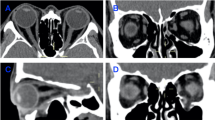Abstract
Purpose
This retrospective study aimed to analyze the relationship between the volume of the fractured and the normal orbit in patients with unilateral orbital fractures with and without indirect traumatic optic neuropathy (TON).
Subjects
Data of 25 patients with unilateral orbital fractures who underwent computer tomography between January 2016 and December 2020 were investigated. Emergency imaging was performed within 2 hours of arrival at the emergency room. The subjects were categorized into two groups: unilateral orbital fractures with and without TON.
Methods and measures
The assessment of TON was performed during a comprehensive ophthalmologic examination by an ophthalmologist. The stereographic orbit was reconstructed, and the volume was calculated. Other variables examined included age, sex, and cause of orbital trauma. The variables were compared using paired t-tests. Statistical significance was set at p < 0.05.
Results
The orbital volume of the non-fractured orbit was 27.50 ± 2.26 and 27.48 ± 2.64 cm3 in the groups with and without TON, respectively. The average volume of the fractured orbit in the TON group was 27.78 ± 2.56 cm3, and there was no significant volumetric difference between the fractured and non-fractured sides in this group. However, the average volume of the fractured orbit without TON was 28.76 ± 3.18 cm3, larger than that of the non-fractured orbit (p = 0.016).
Conclusions
Non-expansion of the fractured orbit was a risk factor for indirect TON in patients with unilateral orbital fractures. Volumetric analysis from primary imaging would expedite the diagnosis and treatment of TON, resulting in optimal outcomes.


Similar content being viewed by others
References
Steinsapir KD, Goldberg RA (1994) Traumatic optic neuropathy. Surv Ophthalmol 38:487
Jamal BT, Pfahler SM, Lane KA et al (2009) Ophthalmic injuries in patients with zygomaticomaxillary complex fractures requiring surgical repair. J Oral Maxillofac Surg 67:986
Lee V, Ford R, Xing W et al (2010) Surveillance of traumatic optic neuropathy in the UK. Eye 24:240
Mahapatra A, Tandon D (1993) Traumatic optic neuropathy in children: a prospective study. Pediatr Neurosurg 19:34
Steinsapir KD, Goldberg RA (2011) Traumatic optic neuropathy: an evolving understanding. Am J Ophthalmol 151:928
Deck C (2008) Willinger Rm: improved head injury criteria based on head FE model. Int J Crashworthiness 13:667
Cirovic S, Bhola RM, Hose DR et al (2006) Computer modelling study of the mechanism of optic nerve injury in blunt trauma. Br J Ophthalmol 90:778
Thale A, Jungmann K, Paulsen F (2002) Morphological studies of the optic canal. Orbit 21:131
Wi J, Sung K, Chi M (2017) ‘Orbital volume restoration rate after orbital fracture’; a CT-based orbital volume measurement for evaluation of orbital wall reconstructive effect. Eye 31:713
Yang J-H, Hwang SB, Shin JY et al (2019) 3-Dimensional volumetric analysis of relationship between the orbital volume ratio and enophthalmos in unoperated blowout fractures. J Oral Maxillofac Surg 77:1847
Ahn HB, Ryu WY, Yoo KW et al (2008) Prediction of enophthalmos by computer-based volume measurement of orbital fractures in a Korean population. Ophthalmic Plast Reconstr Surg 24:36
Whitehouse R, Batterbury M, Jackson A et al (1994) Prediction of enophthalmos by computed tomography after’blow out’orbital fracture. Br J Ophthalmol 78:618
Regensburg NI, Kok PH, Zonneveld FW et al (2008) A new and validated CT-based method for the calculation of orbital soft tissue volumes. Invest Ophthalmol Vis Sci 49:1758
Sentucq C, Schlund M, Bouet B et al (2021) Overview of tools for the measurement of the orbital volume and their applications to orbital surgery. J Plast Reconstr Aesthet Surg 74:581
Kumaran AM, Sundar G, Chye LT (2015) Traumatic optic neuropathy: a review. Craniomaxillofac Trauma Reconstr. 8(1):31–41
Smith DH, Meaney DF (2000) Axonal damage in traumatic brain injury. Neuroscientist 6:483
Kashkouli, M.B., Yousefi, S., Nojomi, M. et al.(2018) Traumatic optic neuropathy treatment trial (TONTT): open label, phase 3, multicenter, semi-experimental trial. Graefes Arch Clin Exp Ophthalmol 256(1):209–218
McCallum E, Keren S, Lapira M et al (2019) Orbital compartment syndrome: an update with review of the literature. Clin Ophthalmol (Auckland, NZ) 13:2189
Ebrahimi A, Motamedi MHK, Rasouli HR et al (2019) Enophthalmos and orbital volume changes in zygomaticomaxillary complex fractures: is there a correlation between them? J Oral Maxillofac Surg 77:134e1–134.e9
Nagasao T, Morotomi T, Kuriyama M et al (2018) Biomechanical analysis of likelihood of optic canal damage in peri-orbital fracture. Comput Assist Surg 23:1
Funding
None.
Author information
Authors and Affiliations
Contributions
WS: Conceptualization, Methodology, Software, Writing—Original Draft AY: Conceptualization, Methodology, Writing—Review & Editing, Visualization JYK: Visualization, Investigation, Writing—Review & Editing JKK: Formal analysis, Visualization JKH: Conceptualization, Methodology, Resources Supervision, Project administration. All authors: final approval and agree to be accountable for all aspects of the work.
Corresponding author
Ethics declarations
Conflict of interest
No conflicting relationship exists for any authors.
Additional information
Publisher's Note
Springer Nature remains neutral with regard to jurisdictional claims in published maps and institutional affiliations.
Rights and permissions
Springer Nature or its licensor holds exclusive rights to this article under a publishing agreement with the author(s) or other rightsholder(s); author self-archiving of the accepted manuscript version of this article is solely governed by the terms of such publishing agreement and applicable law.
About this article
Cite this article
Senarak, W., Yongvikul, A., Ku, JK. et al. Effect of orbital volume in unilateral orbital fracture on indirect traumatic optic neuropathy. Int Ophthalmol 43, 1121–1126 (2023). https://doi.org/10.1007/s10792-022-02509-w
Received:
Accepted:
Published:
Issue Date:
DOI: https://doi.org/10.1007/s10792-022-02509-w




